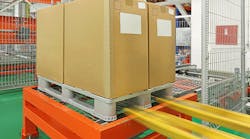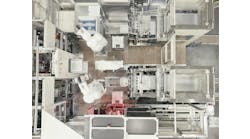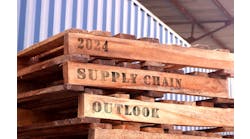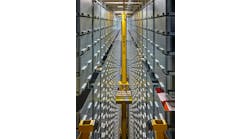Martin Buena-Franco is manager, automation products marketing, at Raymond.
What sorts of sensing technologies have improved the effectiveness and reliability of picking systems and conveyance systems?
Martin Buena-Franco, manager, automation products marketing, Raymond: There’s a wide variety of sensing technology available today to help optimize operations. For example, flexible operator-assist solutions can be programmed to suit individual customers' needs. In-Aisle Detection System (IADS) and other similar technologies reinforce operator best practices and reduce the chances of impacts by utilizing light-detection-and-ranging (LiDAR) technology to alert the operator with visual and audible cues when an object is in the path. IADS can even bring the lift truck to a controlled stop to prevent an impact.
Also read: How close are we to majority-automated warehouses?
Pick-to-light systems are another operator-assist technology. The Pick2Pallet LED light system is designed to help reduce picking errors by using visual indications to reinforce product placement for order fulfillment in batch-picking applications. Another sensing technology includes Zoning and Positioning (ZaP) systems. ZaP technology ensures more reliable, repeatable lift-truck operation by automatically controlling lift-truck functions, such as travel speed and lift height, allowing operators to focus on their surroundings and the task at hand.
As warehouse distribution centers continue to grow larger, how are tracking and intelligence helping to keep up with customer demands?
Martin Buena-Franco, manager, automation products marketing, Raymond: The continued increase in distribution center size is something we’ve been seeing for a few years now, especially as e-commerce and customer demand continues to grow. We've seen higher expectations regarding speed and order accuracy from customers across every industry who want their product to arrive accurately, on time and undamaged.
Additionally, having a clear picture of how products and materials move within the facility is crucial. Implementing the right technology to collect data is very important because you can only analyze the information you can access.
With all the new technology available for vehicles, collecting data to achieve warehouse visibility has become a necessity, not a “nice to have.” By collecting tracking patterns, you can identify the right size of your fleet and find areas of congestion. This enables the opportunity to maximize operational efficiency by adding new routes and tracking capabilities into a warehouse management system.
Which technologies have allowed warehouses to increase throughput rates while expanding product ranges and still maintaining accurate order fulfillment?
Martin Buena-Franco, manager, automation products marketing, Raymond: One way is through the introduction of operator-assist technologies. These technologies help reinforce correct operator behaviors and ensure operators are picking orders accurately and efficiently. ZaP is one example because it automatically controls many order-picker and turret-truck functions in very narrow aisle applications. It guides the truck to its next storage location by taking the most efficient travel path both for the truck speed and the lift height. This allows the operator to make fewer adjustments, thus saving storage time. ZaP helps to reinforce the operator’s training and to minimize impacts and rack or material damage. Another example is Pick2Pallet LED light system, improving efficiency, while batch picking through an LED light system and audio cues that reinforce product placement. Pick2Pallet maximizes productivity by directing operators to the desired customer pallet, enabling them to quickly move to the next pick while reducing pick errors.
Because of the warehouse’s physical nature, how much of the facility’s hardware can be replaced with software in order to facilitate easier upgrades, expansions and reconfigurations?
Martin Buena-Franco, manager, automation products marketing, Raymond: One example where hardware can be replaced with software is flexible automation, such as driverless, infrastructure-free automated guided vehicles (AGVs). These lift trucks require little to no infrastructure changes and can be quickly and easily reprogrammed without having to turn to the OEM to change routes.
Another example is iWarehouse Fleet and Warehouse Optimization System, which can be added to existing lift trucks to collect fleet data and to automate operator checklists and other functions to provide actionable insights to optimize operations. The technology can be added to Raymond lift trucks and requires minimal infrastructure updates. This flexible solution allows facilities to enhance productivity by ensuring proper equipment utilization through geofencing, zoning and tracking capabilities to restrict and control the movements of lift trucks, labor and assets.
How have automated storage and retrieval systems’ roles changed over the past 10 years?
Martin Buena-Franco, manager, automation products marketing, Raymond: Automated-storage-and-retrieval-system (AS/RS) technologies have continued to improve over the years with greater reliability, increased speeds, storage savings up to 80% over shelving and more advanced software to batch pick at rates two to three times the speed of cart picking.
Over the past 10 years, one significant change has been the introduction of AS/RS solutions that simultaneously use multiple robots to move materials to operator stations. This has resulted in increased speed and minimized downtime, allowing for an easier response during peak business times. Operators are now able to remain at their workstations while robots deliver individual storage totes and even whole shelving bays with the operator following lighted displays to pick and fill orders. These goods-to-person picking systems have almost eliminated operator walking time, which accounts for 50% or more of the traditional picker's time.
Will autonomous mobile robots replace automated guided vehicles altogether, or is there room for both, based on the application or complementary functions?
Martin Buena-Franco, manager, automation products marketing, Raymond: Both AGVs and autonomous mobile robots (AMRs) offer flexible automation and will likely continue to be used in the future. To find the best solution, operators can turn to a trusted partner to help them determine which solution makes sense for their needs.
How will ANSI/RIA R15.08 affect robotic solutions in warehouse environments?
Martin Buena-Franco, manager, automation products marketing, Raymond: R15.08 is helping to create a clearer distinction between AGVs and AMRs in the material-handling industry. These terms are still being used interchangeably while the definitions of AGVs and AMRs have changed to distinguish two distinct technologies. Recent updates also suggest ANSI/B56 will serve more as the governing body for AGVs and R15.08 for AMRs. Additionally, R15.08 addresses autonomous navigation from a safety standard, including inherent safe design, protective measures and information for use of industrial robots.
Given the extraordinary percentage of manual operation in most distribution centers, will the 24/7 fully autonomous warehouse order fulfillment center ever become commonplace?
Martin Buena-Franco, manager, automation products marketing, Raymond: I believe there will always be room for people. It’s likely we’ll see robots and automated solutions be used to complete tasks that are considered dirty, dangerous and repetitive while people will fill roles in more specialized tasks that require creativity, flexibility and decision-making. There’s no doubt that automated solutions offer higher levels of performance in repeatability, accuracy and reliability but they’re not a one-size-fits-all solution and will likely never be able to replace decision-making roles where people excel.






